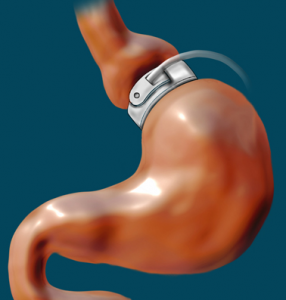The Lap Band Surgery Procedure — Dr. Christine Ren-Fielding
UncategorizedA Closer Examination of Laparoscopic Adjustable Gastric Banding
Bariatric surgery can help obese patients lose weight, keep it off, and avoid development of obesity-related health risks. In this blog series hosted by Dr. Christine Ren-Fielding, we explore lap band surgery, one of the least invasive and lowest risk weight loss surgery options. In the previous article, we examined some of the indications which lead to recommendation of lap band surgery. Here, we take a closer look at the surgical procedure as performed by Dr. Christine Ren-Fielding and the NYU Langone Weight Management Program team.
How Does Laparoscopic Adjustable Gastric Banding Work?
During laparoscopic adjustable gastric banding, a medical device called a lap band is placed around the upper portion of the stomach. This creates a stomach pouch, which fills with significantly smaller portion sizes. By consistently alleviating hunger with fewer calories, the patient’s eating new eating habits result in significant weight loss over time. Because the remainder of the stomach and digestive system is left intact, nutrients are still fully absorbed.

The lap band is placed near the top of the stomach to form a smaller stomach pouch during this bariatric surgery.
Surgical Placement of the Gastric Band
Placement of the lap band is done under general anesthesia. Like many other bariatric surgery procedures, lap band surgery is done using a laparoscope. This surgical tool has a tiny camera on the end, which allows the surgeon to visualize their work without making large incisions.
First, a small cut is made by the belly button and the abdomen is filled with carbon dioxide so the surgeon can view their work. The surgeon then makes additional incisions to insert the lap band and the port which will be used to adjust band size.
Because the incisions required for laparoscopic surgeries are so small, both surgery and recovery times tend to be significantly shorter than those for conventional surgeries. Lap band surgery also offers easier recovery and lower surgical risks than other bariatric surgery procedures due to its relative simplicity. No incisions to the stomach or small intestines are made as with gastric bypass and other procedures. Because of this, risk of postoperative complications and mortality are lowest among the bariatric surgery options.
Lap Band Adjustment Over Time
The lap band will be adjusted after surgery by inflating or deflating it based on the needs of the patient. If it has become loose, for example, it will no longer help control appetite and the patient will benefit from a “fill” via the port. If the patient is feeling discomfort or experiencing reflux, the band can be deflated and loosened. Passage of materials through the port can be visualized via X-ray fluoroscopy, observing the band size and placement. Proper adjustment of the lap band after surgery is key to weight loss success.
For a Bariatric Surgery Consultation with Dr. Christine Ren-Fielding
To discuss lap band surgery and evaluate your weight loss surgery options, please contact Dr. Christine Ren-Fielding at the NYU Langone Weight Management Program.
No comments yet.